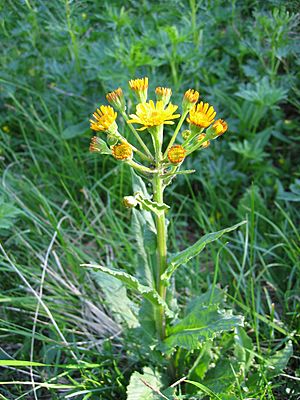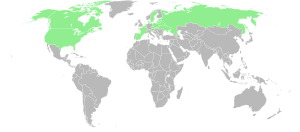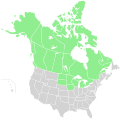Senecio congestus facts for kids
Quick facts for kids Senecio congestus |
|
|---|---|
 |
|
| Scientific classification | |
 |
|
| Range of S. congesta | |
| Synonyms | |
|
Cineraria congesta R. Br.
|
Senecio congestus, also known as swamp ragwort, is a plant with bright yellow flowers. You can easily spot it from May to early July. It grows about 3 to 4 feet (0.9 to 1.2 meters) tall. This plant likes wet places like marshes, stream banks, and slough areas. It belongs to the daisy family, Asteraceae, and the group of plants called Senecio.
Contents
What is Swamp Ragwort?
Like many plants in the Senecio group, S. congestus can be an annual or biennial plant. This means it might live for one year or two years. Sometimes, it might even be a perennial plant, living for more than two years. This depends on where it grows.
How Does it Look?
Swamp ragwort is a plant with broad leaves that have soft, fine hairs (called villous). It has a single hollow stem. It prefers muddy areas, similar to Marsh Groundsel. However, swamp ragwort cannot grow in very salty places or in standing water.
When the plant is young, its leaves, stem, and flower heads are covered with tiny, clear hairs. These hairs create a "greenhouse effect" close to the plant's surface. This helps the plant stay warm and grow for a few extra days, which is very important.
Leaves and Stems
This plant stands straight up, from 6 to 60 inches (15 to 150 cm) tall. Its height can change a lot, just like how much hair (called tomentum) it has. The stems have soft hairs and are more hollow near the bottom. These hairs can be white, yellowish, or reddish-brown.
The edges of the leaves, both at the bottom (basal) and along the stem (cauline), are mostly smooth or have a few rough teeth. Sometimes, these lower leaves dry up before the flowers bloom. All the leaves are generally similar in shape, like an oblong. The lower leaves are often spoon-shaped (spatulate). They are 1.6 to 8 inches (4 to 20 cm) long and 0.2 to 2.5 inches (0.5 to 6 cm) wide. The basal leaves can sometimes be larger. They can be smooth (glabrous) or have patches of soft hairs. Their tips are rounded, and they have teeth. They often fall off (deciduous) and have bases that wrap around the stem.
Flowers
The flowers grow in "congested" (meaning crowded) clusters. There are usually many pale yellow flower heads. Sometimes, they look like tubes and don't open completely. Each plant has a branched flower cluster (inflorescence), with 13 to more than 21 flower heads on each stalk.
Each flower head is about ¼ to ½ inch (6 to 13 mm) across and 0.16 to 0.4 inch (0.4 to 10 mm) long. They have small but clear rays (the petal-like parts) in a flower structure (corolla). These are surrounded by about 21 green or yellowish-green bracts (leaf-like parts) that often have pink tips. These bracts can be dry and thin (scarious) towards their ends.
Seeds and Roots
Like other Senecio plants, S. congestus produces small, dry seeds. Each seed is 1.5 to 2.5 millimeters long and has one cell. They have many fine, white or off-white, fluffy bristles (pappus) that help them fly in the wind. These seeds can stay alive in the soil for more than a year, but usually less than 5 years. We don't know their maximum lifespan.
The roots of the plant are thin and spread out (fibrous). It does not have a main, thick taproot.
Where Does Swamp Ragwort Grow?
Senecio congestus grows in places with cold winters and wet soil. You can find it in damp meadows, swamps, sandy edges of ponds, and ditches along roads. It grows at heights from sea level up to about 3,300 feet (1,000 meters).
It is the most common plant that lives for only one year in the eastern Canadian Arctic.
Its Home Countries
Swamp ragwort is originally from:
- America
- Asia
- Northwestern Asia: Many regions in Russia, including Astrakhan Oblast, Bashkortostan, Belgorod Oblast, Bryansk Oblast, Chuvashia, Franz Josef Land, Kalmykia, Kaluga Oblast, Kirov Oblast or Vyatka, Kursk Oblast, Lipetsk Oblast, Mordovia, Novgorod Oblast, Novaya Zemlya, Orenburg Oblast, Penza Oblast, Perm Krai, Pskov Oblast, Rostov Oblast, Ryazan Oblast, Saint Petersburg, Samara Oblast, Saratov Oblast, Tambov Oblast, Tatarstan, Tula Oblast, Ulyanovsk Oblast, Udmurtia, Volgograd Oblast, Voronezh Oblast
- Europe
- Northern Europe: Denmark, Estonia, Latvia, Sweden
- Middle Europe: Czech Republic, Poland
- East Europe: Belarus, Kaliningrad Oblast, Lithuania, Ukraine
- West Europe: France, Luxembourg, Netherlands
- Southeastern Europe: Croatia
Where It Grows Now
Today, you can find Senecio congestus in these places:
- America
- Asia
- Northwestern Asia: Many regions in Russia, including Astrakhan Oblast, Bashkortostan, Belgorod Oblast, Bryansk Oblast, Chuvashia, Franz Joseph Land, Kalmykia, Kaluga Oblast, Kirov Oblast or Vyatka, Kursk Oblast, Lipetsk Oblast, Mordovia, Novgorod Oblast, Novaya Zemlya, Orenburg Oblast, Penza Oblast, Perm Krai, Pskov Oblast, Rostov Oblast, Ryazan Oblast, Saint Petersburg, Samara Oblast, Saratov Oblast, Tambov Oblast, Tatarstan, Tula Oblast, Ulyanovsk Oblast, Udmurtia, Volgograd Oblast, Voronezh Oblast
- Europe
- Northern Europe: Denmark, Estonia (its numbers are going down here), Latvia, Sweden
- Middle Europe: Czech Republic, Poland, Slovakia
- East Europe: Belarus, Kaliningrad Oblast, Lithuania, Ukraine
- West Europe: Belgium, France, Luxembourg, Netherlands
- Southeastern Europe: Croatia
- Southwestern Europe: Andorra, Gibraltar, Spain
Maps of Its Range
Is Swamp Ragwort Safe or Harmful?
Can You Eat It?
Unlike many plants in the Senecio group, swamp ragwort is actually considered safe to eat for humans! The young leaves and flowering stems of Senecio congestus can be eaten raw in salads. You can also cook them like a vegetable or even make them into a "sauerkraut."
When It Becomes a Problem
Senecio congestus is on a list of plants to watch in North Dakota. However, it usually grows in places that have been badly disturbed. For example, it might appear where animals have eaten too much of the other plants. It also grows where the soil has become very salty.
This has happened in areas where many arctic geese live. Their large populations eat too many plants, leaving the ground bare. Then, swamp ragwort and other plants that the geese don't eat start to grow.
Here are some examples:
- On Akimiski Island in Canada, areas that used to have good grass for geese are now muddy. They grow plants like Senecio congestus that the geese don't eat.
- Near Cape Churchill and La Pérouse Bay in Manitoba, many snow geese have changed the coastal areas. Senecio congestus is now common there.
- At Karrak Lake, Nunavut, more geese have led to less plant cover. Areas where geese have nested for a long time have more bare ground and more Senecio congestus.
Senecio congestus is reported to be no longer found (extirpated) in Michigan.




